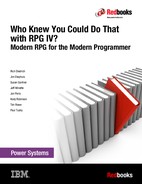Book Description
Application development is a key part of IBM® i businesses. The IBM i operating system is a modern, robust platform to create and develop applications. The RPG language has been around for a long time, but is still being transformed into a modern business language.
This IBM Redbooks® publication is focused on helping the IBM i development community understand the modern RPG language. The world of application development has been rapidly changing over the past years. The good news is that IBM i has been changing right along with it, and has made significant changes to the RPG language. This book is intended to help developers understand what modern RPG looks like and how to move from older versions of RPG to a newer, modern version. Additionally, it covers the basics of Integrated Language Environment® (ILE), interfacing with many other languages, and the best tools for doing development on IBM i.
Using modern tools, methodologies, and languages are key to continuing to stay relevant in today's world. Being able to find the right talent for your company is key to your continued success. Using the guidelines and principles in this book can help set you up to find that talent today and into the future.
This publication is the result of work that was done by IBM, industry experts, business partners, and some of the original authors of the first edition of this book. This information is important not only for developers, but also business decision makers (CIO for example) to understand that the IBM i is not an 'old' system. IBM i has modern languages and tools. It is a matter of what you choose to do with the IBM i that defines its age.
